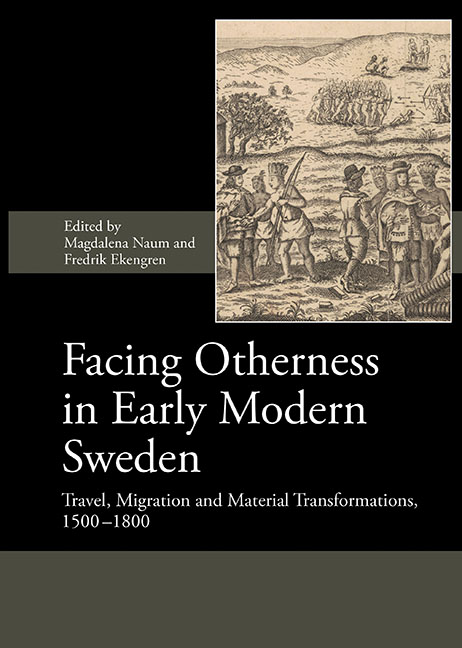Book contents
- Frontmatter
- Contents
- List of Illustrations
- List of Contributors
- Preface
- List of Abbreviations
- I Material Transformations
- Introduction
- 1 Tracing Other in 17th-Century Sweden
- 2 Houses of Wood, Houses of Stone: On Constructing a Modern Town in Early Modern Kalmar
- 3 Indigeneity, Locality, Modernity: Encounters and their Effects on Foodways in Early Modern Tornio
- 4 Brewing an Ethnic Identity: Local and Foreign Beer Brewing Traditions in 15th- to 17th-Century Sweden – an Example from Nya Lödöse
- 5 Tactile Relations: Material Entanglement between Sweden and its Colonies
- II Migration and Neighbourly Interactions
- III Overseas Travel
- IV Conclusions
- Index
5 - Tactile Relations: Material Entanglement between Sweden and its Colonies
from I - Material Transformations
Published online by Cambridge University Press: 23 July 2019
- Frontmatter
- Contents
- List of Illustrations
- List of Contributors
- Preface
- List of Abbreviations
- I Material Transformations
- Introduction
- 1 Tracing Other in 17th-Century Sweden
- 2 Houses of Wood, Houses of Stone: On Constructing a Modern Town in Early Modern Kalmar
- 3 Indigeneity, Locality, Modernity: Encounters and their Effects on Foodways in Early Modern Tornio
- 4 Brewing an Ethnic Identity: Local and Foreign Beer Brewing Traditions in 15th- to 17th-Century Sweden – an Example from Nya Lödöse
- 5 Tactile Relations: Material Entanglement between Sweden and its Colonies
- II Migration and Neighbourly Interactions
- III Overseas Travel
- IV Conclusions
- Index
Summary
This chapter deals with the exchange of material culture between Sweden and its colonies, focusing in particular on the colony of New Sweden (1638–55). It traces some of the Native American objects in Sweden, discusses their meaning and use in the new environment and places them in the context of collecting of exotic artefacts. An object-biographical approach underlines the complexity and relevance of things in a colonial situation. Both America and Sweden were influenced by the material culture of colonial contact; this material culture became part of a process that changed people and societies on both sides of the Atlantic.
By enforcing colonial institutions in the region, the colony of New Sweden left traces in America. New Sweden, however, had an impact on those who served in the colony, who corresponded with the old country and in some cases those who came back to Sweden. The returnees brought with them things: objects that served as physical reminders of their extraordinary experience. Some of these experiences seem to have been important and formative for the continued development of these people's lives. The former governor of New Sweden, Johan Printz, for instance, kept material objects from his time in the colony throughout his life, and so too did his daughter Armegot. The pastor Johannes Campanius Holm, who served in the colony from 1643 to 1648, and who translated Luther's Catechism into Algonquin, had his grave slab in Sweden inscribed in the Native American language. One may ask if these objects and material imprints were brought to the old country out of nostalgia, or whether other sentiments too were included: it is well recorded that Johan Printz disliked living in the colony, and the same probably went for Johannes Campanius Holm. Yet Printz actually used objects he obtained from the native inhabitants in America and he kept them all of his life.
Certain aspects of these entangled histories of people and things related to the New Sweden colony will be discussed in this chapter, where I will examine the context of the collection of indigenous material culture from Lenapehoking and north-east America in mid-17th-century Sweden. As a parallel to this, I will also discuss the use of material culture traded by the Swedes to the Native Americans in the region of the colony.
- Type
- Chapter
- Information
- Facing Otherness in Early Modern SwedenTravel, Migration and Material Transformations 1500–1800, pp. 87 - 104Publisher: Boydell & BrewerPrint publication year: 2018



